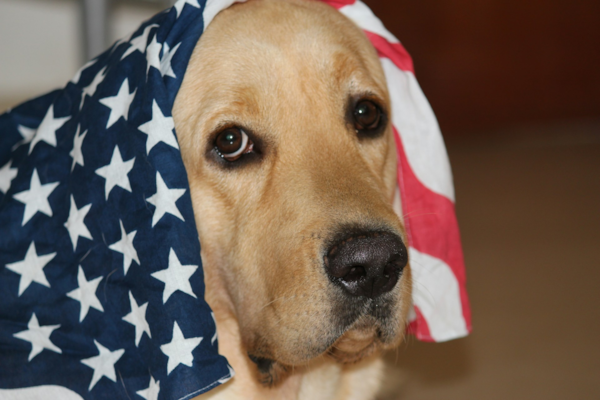
Every year on the Fourth of July, skies burst with color, music blares from backyard speakers, and grills fire up coast to coast. For people, it's a joyful celebration. For many dogs, it can feel like the world is coming apart.
Sudden fireworks, unfamiliar guests, loud noises, and tempting (but risky) foods make the holiday overwhelming for pets. In fact, the American Kennel Club reports that more dogs go missing on July 4th than on any other day of the year. Panic causes them to bolt through open doors, scale fences, or dig under gates. Others may shake, hide, or stop eating altogether.
That’s why keeping your dog safe during the 4th of July means planning ahead, watching for stress signals, and knowing what to avoid. The good news? A few simple choices can make the difference between a traumatized dog and a calm, cared-for companion.
In this guide, you’ll find practical, vet-backed tips to help your dog stay safe and secure. From creating a quiet retreat to recognizing anxiety signs early, each section is designed to give you peace of mind, and give your dog a quieter, safer holiday.
Table of Contents
- Fireworks Anxiety: The #1 Threat to Dogs on Independence Day
- Prepare Ahead: The Calm Starts Before the Chaos
- Desensitize with Firework Sounds - But Start Early
- Calming Aids: What Works and What’s Hype
- Exercise Early to Reduce Energy and Tension
- Food Safety: What Not to Feed Your Dog at a Cookout
- Heat and Hydration: Watch the Thermometer
- Backyard and Water Safety Tips for Outdoor Dogs
- Lake, Pool & Boating Safety (Often Overlooked!)
- After the Fireworks: Recovery and Cleanup
- What If Your Dog Goes Missing? Step-by-Step Guide
- Vet-Backed Advice: When to Call for Professional Help
- Final Thoughts: Keeping Your Dog Safe Is the Best Celebration
Fireworks Anxiety: The #1 Threat to Dogs on Independence Day

For many dogs, fireworks aren’t just startling, they're terrifying. The sudden, sharp bangs and whistling bursts set off an instinctive reaction rooted in survival. Unlike thunder, which comes with some natural warning signs like dark clouds or rain, fireworks feel completely unpredictable. That unpredictability is exactly what makes them so alarming.
Dogs process the world through sound, scent, and routine. A loud noise that comes out of nowhere, followed by a flicker of light or vibration, can trigger their fight-or-flight response. Once activated, adrenaline floods their system. They may tremble, pace, bark, or attempt to escape the source of their fear, even if it means jumping a fence or clawing at a door.
Common signs of fireworks anxiety include:
- Shaking or trembling
- Hiding under furniture or in corners
- Panting and drooling
- Barking or whining excessively
- Pacing or restlessness
- Accidents indoors
- Destructive behavior (chewing, digging)
Some pet owners hope their dogs will “toughen up” over time. Unfortunately, that’s not how sound sensitivity works. Without intervention or comfort, noise anxiety often worsens year after year. The brain begins to associate even minor cues like the smell of smoke or sight of sparklers with fear. This can lead to a longer recovery period, more intense reactions, and even chronic stress.
The American Kennel Club offers detailed advice on identifying and managing this form of anxiety. Their expert guidance is especially helpful if your dog’s reactions have been growing stronger over time. Visit the AKC’s resource on noise phobia for deeper insight and tips.
Taking fireworks anxiety seriously is one of the most important ways you can protect your dog on the Fourth of July.
Prepare Ahead: The Calm Starts Before the Chaos
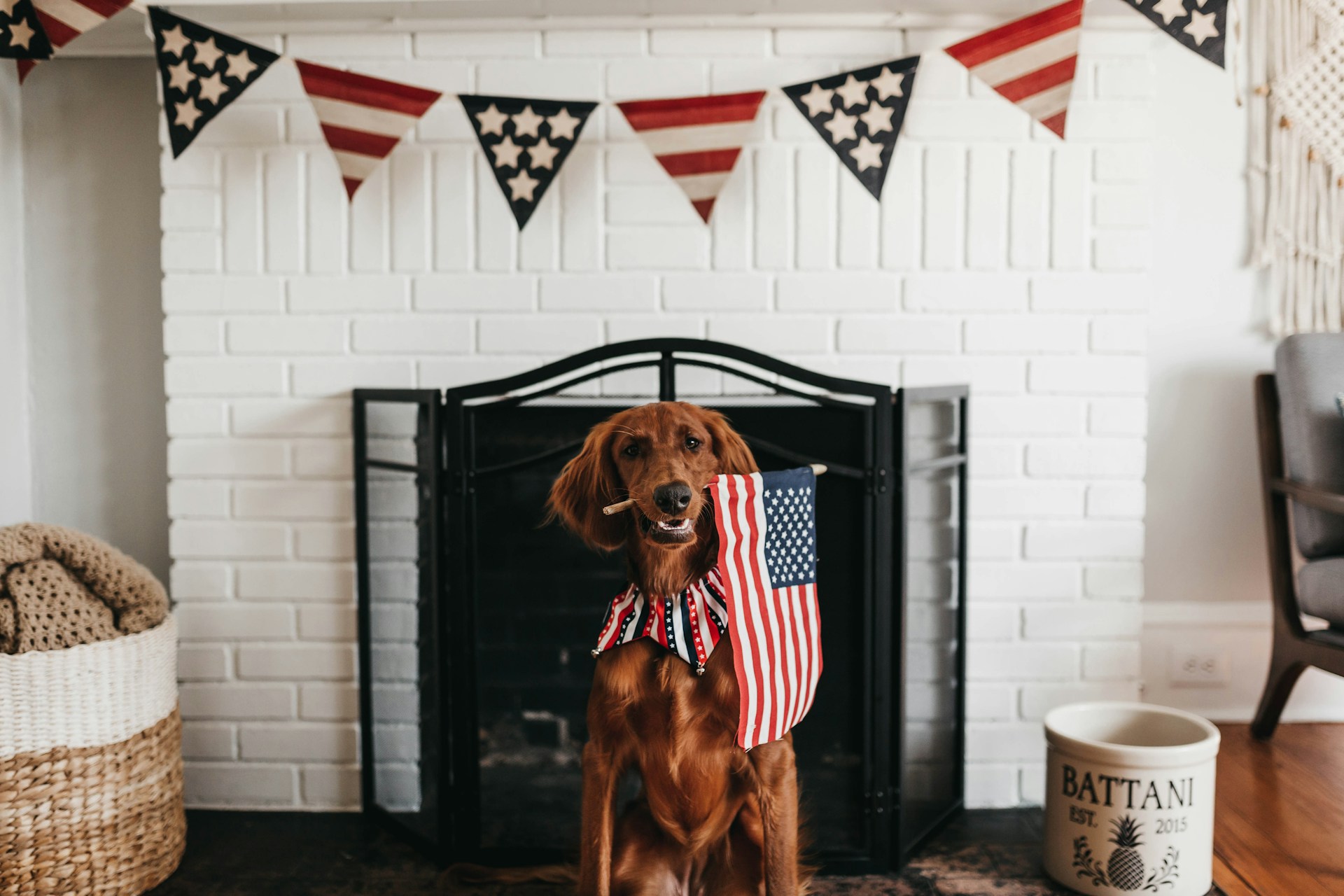
The best way to protect your dog on the Fourth of July starts with what you do before the noise begins. Small actions taken in advance can make your home feel like a safe retreat when the fireworks start popping. Think of it as setting the stage for comfort and control.
Create a Quiet, Safe Space Indoors
Choose a calm, low-traffic room where your dog already feels secure. This space should be away from exterior doors and windows to help muffle outside sounds. A walk-in closet, bathroom, or interior bedroom can work well.
Lay down familiar items like their favorite blanket, bed, and toys. Add soft lighting and, if possible, play white noise or a calming playlist to help block sharp bursts of sound. Many dogs respond well to predictable sensory input like a fan or soft TV background because it creates a steady rhythm amid the chaos.
Some dogs may prefer a covered crate or a “den” setup with a light sheet draped over the top. Let them choose what feels safest. Avoid locking them in if they seem anxious, as confinement can sometimes worsen fear. Instead, offer the space as a refuge and allow them to come and go freely.
Get Your Dog’s ID and Microchip Info Up-to-Date
Fireworks anxiety leads thousands of dogs to flee their homes every year. Even the most well-behaved pet might panic and slip through a cracked door or broken fence. That’s why having clear, accurate ID is crucial - well before July 4th rolls around.
Here’s what to check:
- Your dog wears a collar with a current, legible ID tag
- The tag includes your cell phone number, not just your address
- Your dog is microchipped, and the registry has your updated info
- You have a clear, recent photo of your dog on your phone
According to the American Veterinary Medical Association, microchipped dogs are more than twice as likely to be reunited with their families. But a microchip only works if your contact info is correct. Take a few minutes to verify your details through your provider or follow AVMA’s microchip guide to get started.
Preparation doesn't have to be complicated, but it does need to be intentional. A quiet room and an accurate ID may not seem like much, but they can make all the difference when stress levels rise and seconds count.
Desensitize with Firework Sounds - But Start Early
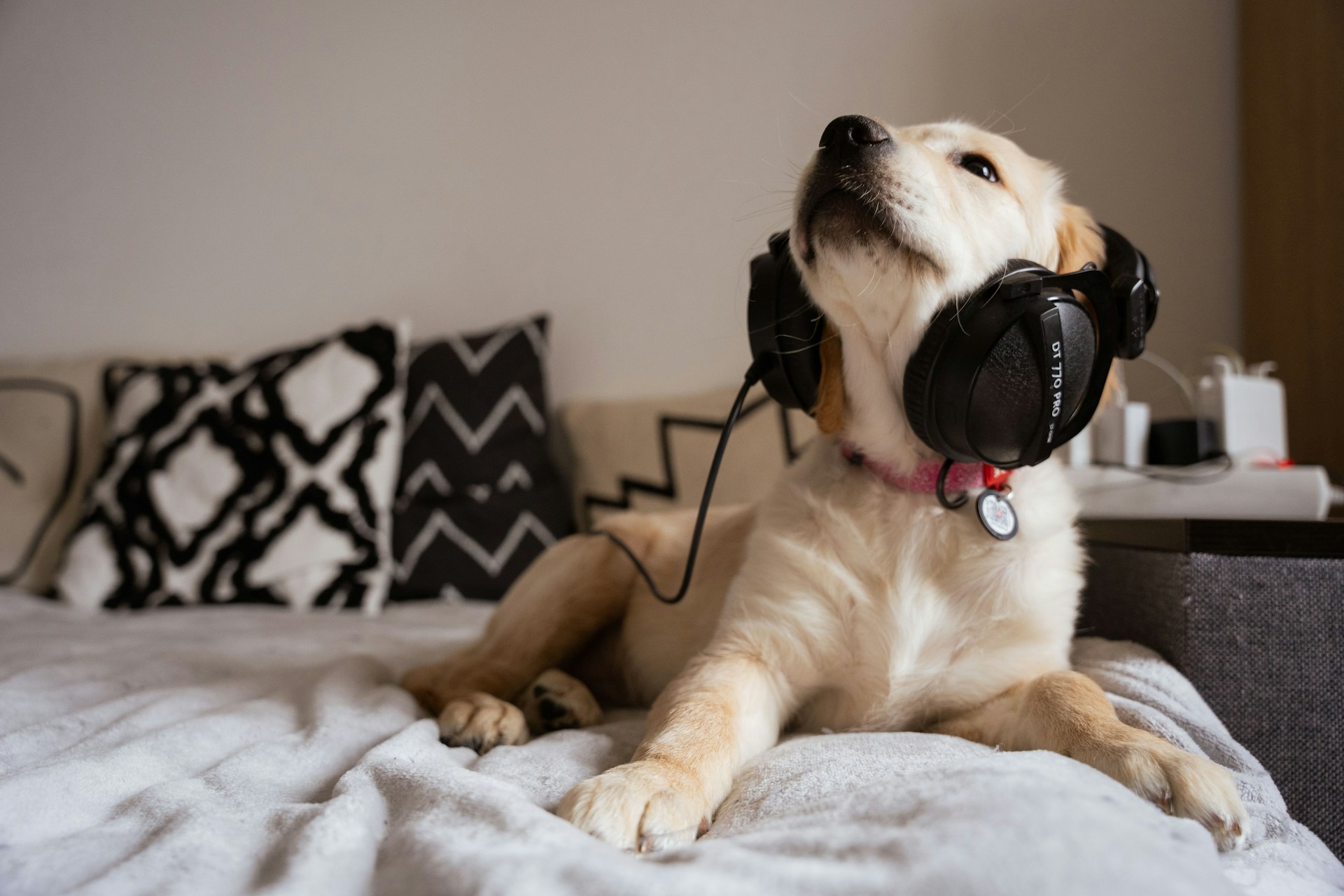
Dogs can learn to feel less afraid of fireworks, but it takes time and a gentle, positive approach. The goal isn’t to force your dog to tolerate loud noises. It’s to help them build confidence in a controlled setting. This is where sound desensitization comes in.
Start by playing recordings of fireworks at a very low volume while your dog is relaxed or engaged in something they enjoy like eating dinner or working on a puzzle toy. Pair the sound with praise, petting, or a few high-value treats. Over time, and only if your dog stays calm, gradually increase the volume by small increments.
The key is to watch their body language closely. If they seem startled, alert, or anxious, turn the volume down or take a break. Training should always end on a positive note. Pushing too hard can reinforce fear instead of building tolerance.
For the best results, this process should begin several weeks before the fireworks season. However, even if the holiday is just around the corner, a few gentle sessions can still help your dog become more comfortable with the idea of distant noises.
Some dogs may need more structured behavior help, especially if they’ve already shown signs of serious noise phobia. In these cases, working with a certified trainer or vet behaviorist can be incredibly valuable. The VCA Animal Hospitals website offers a practical overview of noise desensitization and how to get started safely.
Every dog is different. Some adapt quickly, while others need more time and reassurance. The goal isn’t to erase fear overnight. It’s to build small layers of trust, one quiet step at a time.
Calming Aids: What Works and What’s Hype
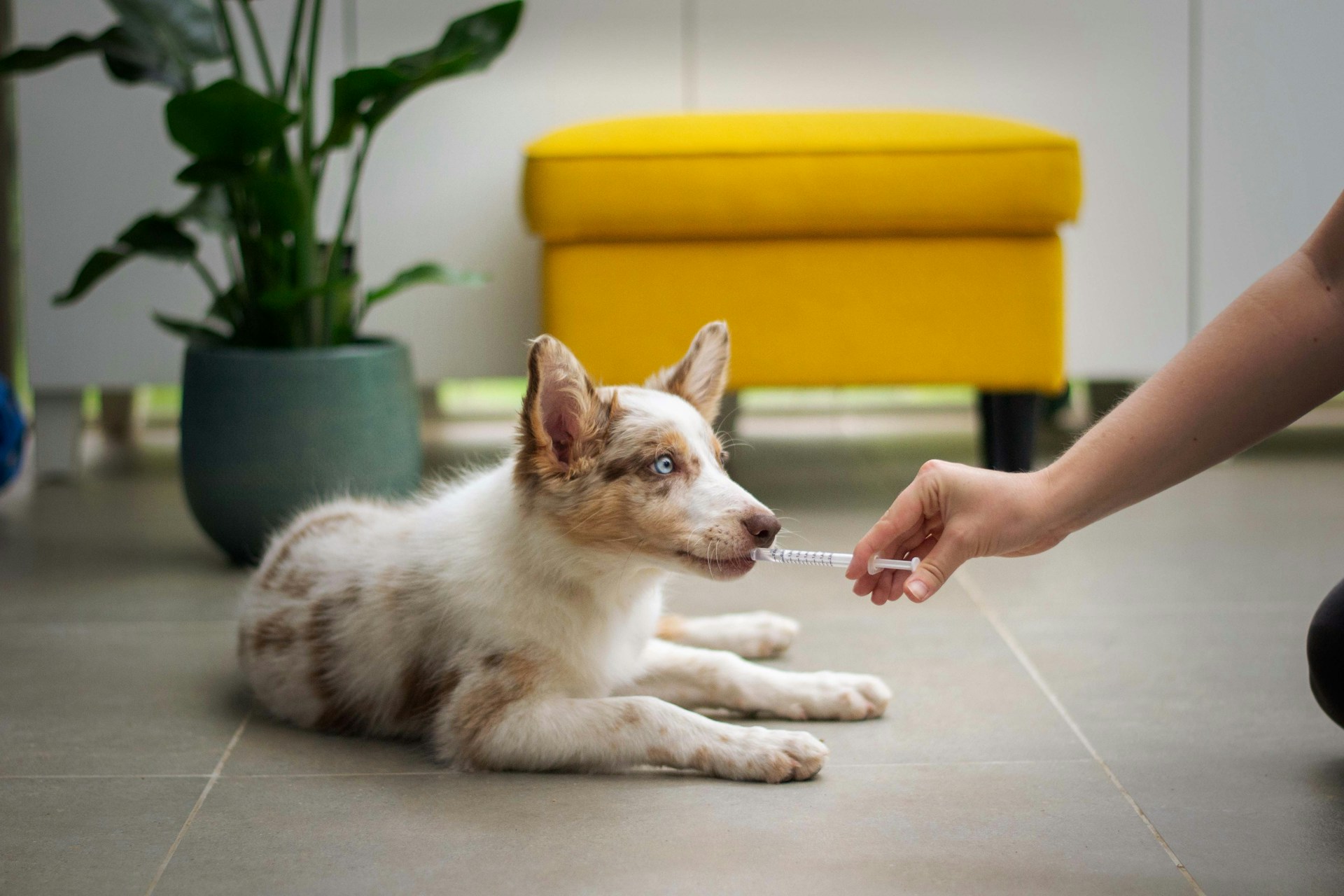
When fireworks season rolls around, shelves fill up with products promising to keep dogs calm. Some offer genuine relief. Others, not so much. Knowing which tools actually help and when to seek professional input can save both money and stress.
Anxiety Vests (e.g., Thundershirts)
Anxiety vests apply gentle, consistent pressure to your dog’s torso, similar to the feeling of being swaddled. This calming effect can help reduce anxiety in some dogs, especially when worn in a familiar, quiet space.
They tend to work best for mild to moderate cases of stress. If your dog is panicking or trying to escape, the vest alone won’t resolve it, but as part of a calming routine, it can be a solid tool. Try putting it on during a relaxed time first, so they associate it with comfort rather than fear.
Some dogs seem indifferent to pressure wraps. Others visibly settle once it’s on. Like many tools, effectiveness can vary.
Pheromone Sprays & Natural Calmers
Dog-appeasing pheromones (DAP) mimic the scent that mother dogs naturally produce to soothe their puppies. They’re available in several forms:
- Plug-in diffusers
- Collar-based releases
- Spray bottles you can apply to bedding or crates
Some pet parents report noticeable calm within an hour or two of using these products. While not a guaranteed fix, they’re generally safe and can be helpful for dogs with mild unease.
There are also natural calming chews and supplements containing ingredients like L-theanine, melatonin, valerian root, or chamomile. These may promote relaxation, but they’re not all created equal. Always check the label, dosage, and source. And never introduce something new on the day of the event. Try it ahead of time to see how your dog reacts.
When to Ask Your Vet for Medication
For dogs with severe fireworks phobia (those who drool, shake uncontrollably, or attempt to escape) it’s time to talk to your vet. In some cases, medication can provide safe, fast relief and prevent long-term anxiety from taking hold.
There’s no one-size-fits-all drug for this. Your vet will consider your dog’s age, weight, health history, and the intensity of their anxiety. You might be prescribed a situational medication, like Sileo, trazodone, or alprazolam, to use only during fireworks events.
These meds are most effective when paired with behavior strategies like safe spaces, soundproofing, or desensitization training. They’re not a cure, but they can provide essential relief during the most stressful nights of the year.
The bottom line? There’s no shame in needing medical help for your dog’s fear. If you’re unsure whether to try supplements or seek a prescription, your veterinarian is the best place to start.
Exercise Early to Reduce Energy and Tension
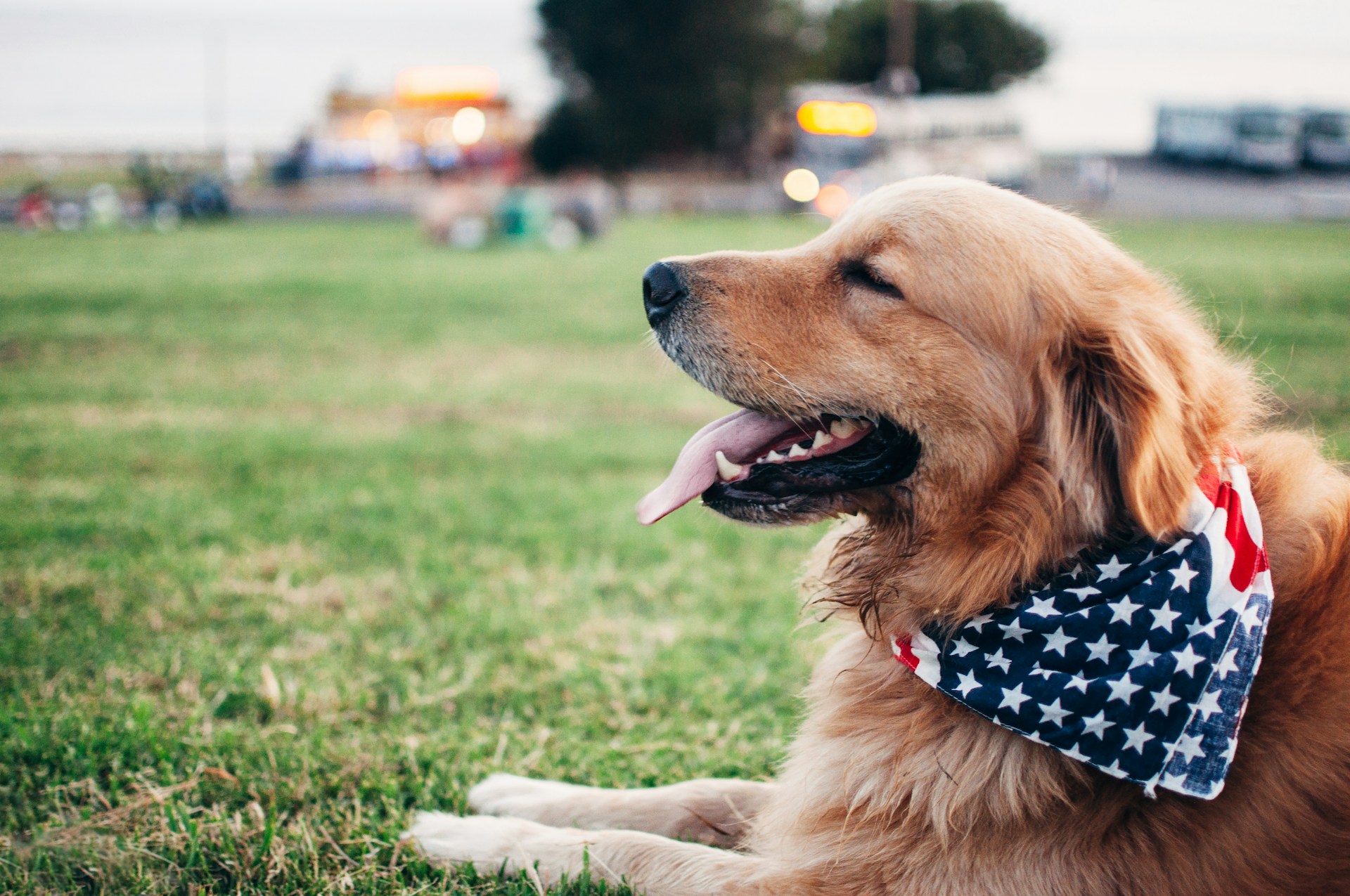
One of the most effective ways to help your dog handle stress on the Fourth of July is surprisingly simple: give them a good workout before the fireworks begin. Physical activity helps lower anxiety by burning off excess energy and triggering feel-good chemicals in the brain. A tired dog is often a calmer dog.
Plan a longer walk, a game of fetch, or some backyard playtime earlier in the day, preferably before the late afternoon heat sets in. Early morning or early evening (well before sunset) is usually the safest window. If it’s warm outside, stick to shaded areas, bring water, and watch for signs of overheating like excessive panting or lagging behind.
Keep in mind that physical exercise doesn’t have to be intense. The goal isn’t exhaustion, it’s contentment.
Mental stimulation works just as well for many dogs. Activities like puzzle feeders, snuffle mats, or hide-and-seek games can challenge their brains and wear them out in a different, more focused way. These can be especially helpful for dogs who can’t tolerate too much activity outdoors due to age, injury, or high heat.
Try this simple combo:
- Morning: 20–30 minute walk + short sniff break
- Midday: Food puzzle or frozen treat toy indoors
- Evening (pre-fireworks): Tug-of-war, training games, or scent work in a quiet room
Food Safety: What Not to Feed Your Dog at a Cookout
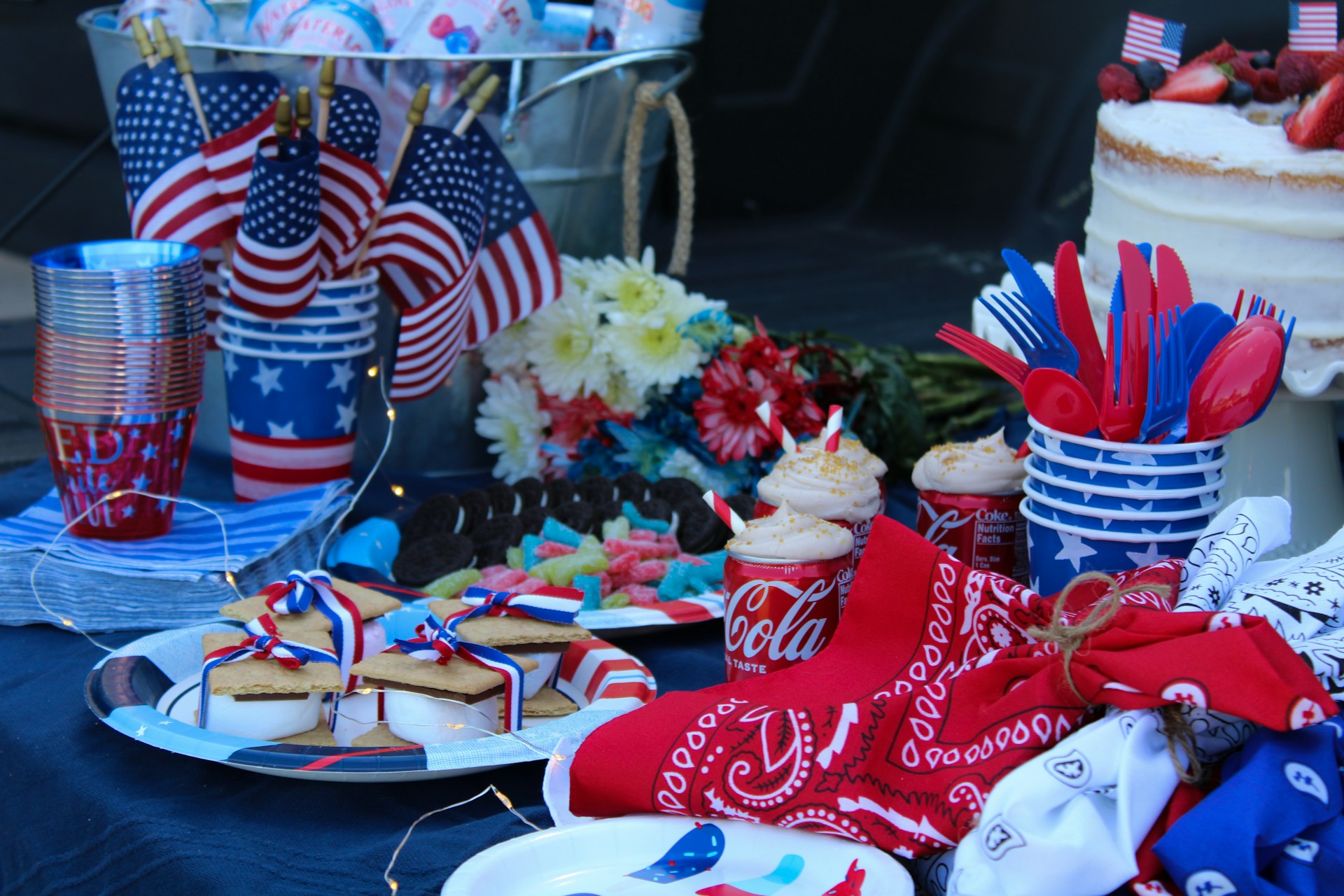
Backyard barbecues and cookouts are a big part of the July 4th celebration. The smells, the plates of food left within reach - it’s a canine dream. But a lot of what's on that picnic table can be dangerous, even life-threatening, for dogs.
Dangerous Foods Common on July 4th
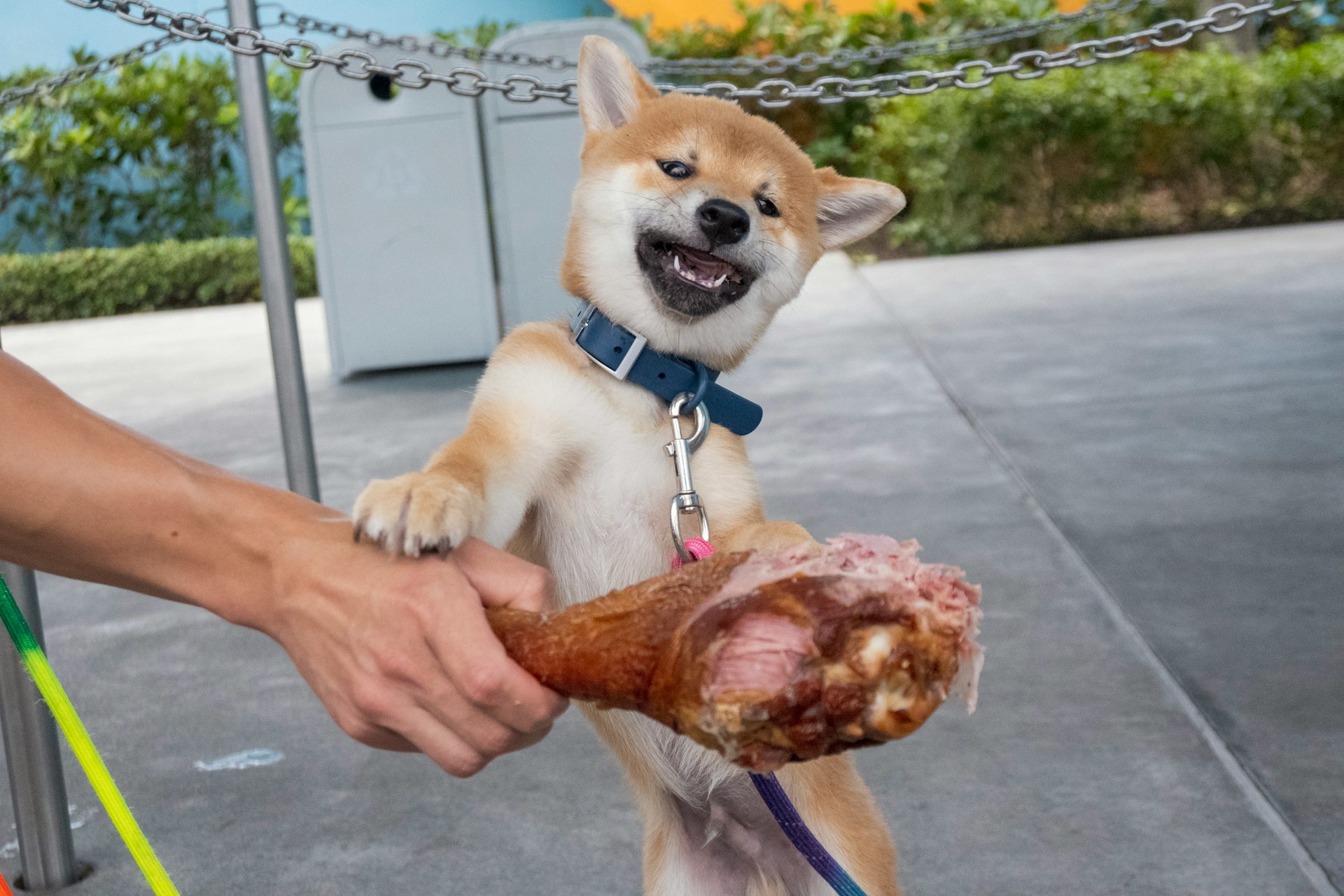
Some holiday favorites are toxic or risky to dogs, even in small amounts. Here’s what to keep far away from your pup:
- Chocolate – Highly toxic, especially dark varieties
- Grapes and raisins – Can cause kidney failure
- Onions and garlic – Damages red blood cells
- Cooked bones – May splinter and cause choking or intestinal damage
- Alcohol – Even a small sip can lead to vomiting, disorientation, or worse
- Corn cobs and skewers – Can block or perforate the intestines
Greasy burgers, leftover ribs, or anything seasoned with garlic or onion powder should also be off-limits. Even if your dog begs with those big eyes, it’s not worth the risk.
RELATED: 10 Human Foods You Should Never Feed Your Dog
What They Can Have (in Moderation)
You don’t need to exclude your dog completely from the celebration. A few simple, safe treats can keep them happy while everyone else enjoys their meal:
- Plain grilled chicken or turkey – No seasoning, skin, or bones
- Watermelon – Seedless and rind-free
- Blueberries or apple slices – Avoid cores and seeds
- Carrot sticks or green beans – Crunchy and low in calories
Serve treats in small pieces, and only if your dog has had them before without issue. Always supervise, especially when kids or guests are involved. Well-meaning people often share snacks without knowing what’s safe.
For a detailed list of what’s dangerous and why, the ASPCA’s Animal Poison Control has a reliable food safety guide for pet owners. Bookmark it - it’s a solid resource year-round.
RELATED: 11 Human Foods You Can Feed Your Dog
Heat and Hydration: Watch the Thermometer

While fireworks tend to steal the spotlight, summer heat is an equally serious risk for dogs on the Fourth of July. Warm weather celebrations often mean extended time outdoors, and without the right precautions, that can quickly turn dangerous.
Dogs don’t sweat like humans do. They release heat primarily through panting and a small number of sweat glands in their paws. When temperatures rise, especially with high humidity, this natural cooling system can become overwhelmed.
Know the signs of heatstroke:
- Heavy panting or drooling
- Lethargy or weakness
- Bright red gums or tongue
- Vomiting or diarrhea
- Disorientation or collapse
Heatstroke is a medical emergency. If you notice any of these symptoms, move your dog to a shaded area immediately, offer cool (not ice-cold) water, and contact your vet right away.
How to Stay Safe in the Heat
- Always provide a shady, ventilated space outdoors
- Keep multiple bowls of fresh, cool water accessible
- Avoid walking your dog on hot pavement - it can burn their paws
- Plan walks or playtime in the early morning or late evening
- Bring dogs indoors during the hottest part of the day
- Use cooling mats, damp towels, or fans to help regulate temperature
And it should go without saying: never leave your dog in a parked car, even for a minute. On a mild 75°F day, temperatures inside a vehicle can climb above 100°F in less than 10 minutes. Cracking a window doesn’t make it safe.
Staying mindful of the heat is essential for your dog’s safety and well-being during July festivities.
RELATED: 6 Expert Tips on Keeping Your Dog Safe During Heatwaves
Backyard and Water Safety Tips for Outdoor Dogs
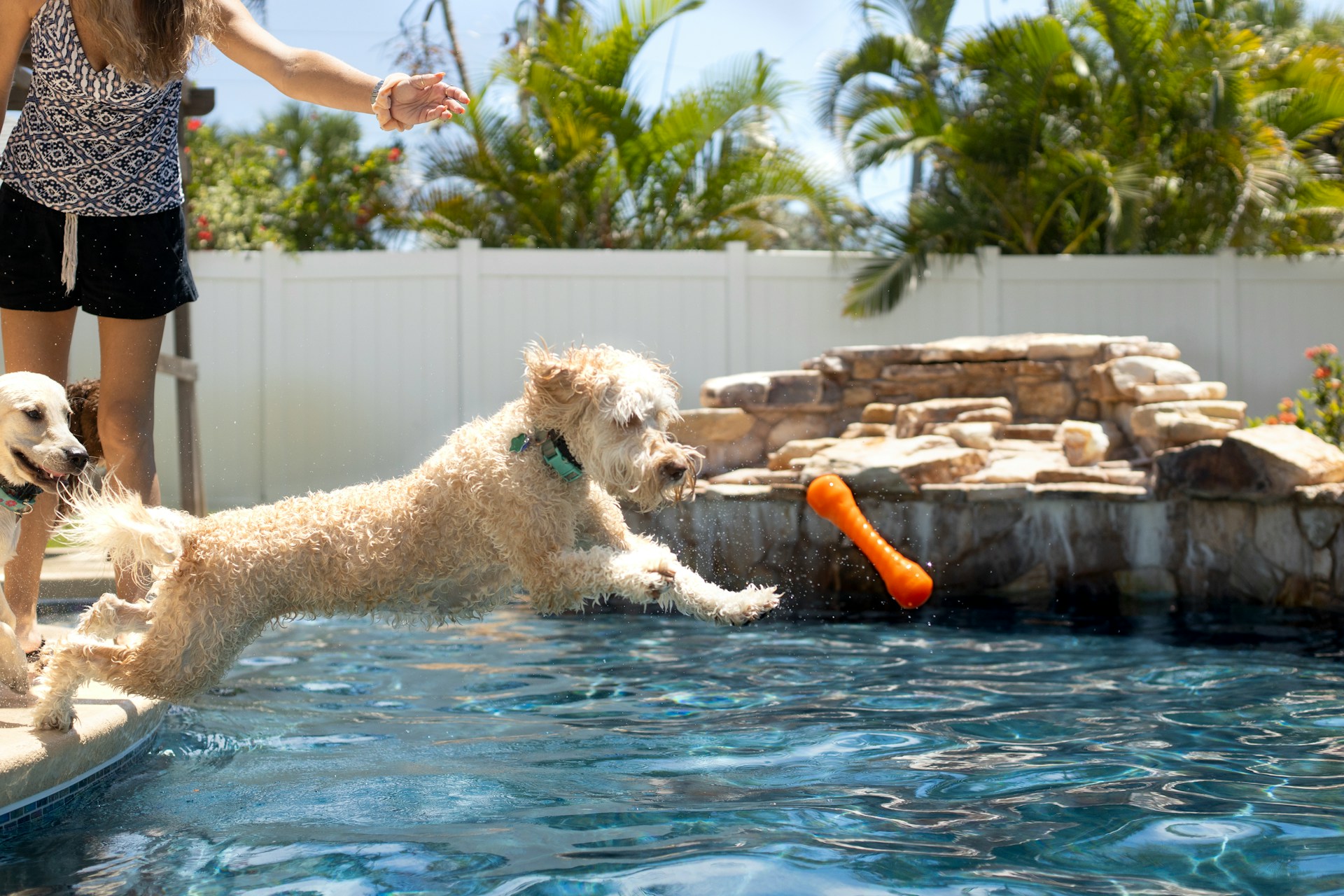
For dogs who spend time outdoors, the Fourth of July presents a unique set of challenges. Even if your pup is usually content in the yard or on the deck, fireworks can trigger behavior you’ve never seen before. That’s why it’s critical to take a few extra precautions.
Supervision Is Non-Negotiable
No matter how secure your yard feels, don’t leave your dog outside alone once the fireworks begin. Even a confident, well-adjusted dog can panic at the sound of a sudden boom. Some will try to dig under fences or leap over them in an attempt to escape the noise. Others may wedge themselves into corners or hurt themselves trying to get indoors.
Keep your dog indoors after dusk, even if fireworks in your area haven’t started yet. Sound can travel farther than expected, and neighborhood celebrations often begin early.
Inspect Gates, Fencing, and Latches
- Before the holiday, do a thorough walk-through of your yard. Look for:
- Loose boards or wobbly panels in your fence
- Gaps near the ground where a dog could dig or squeeze through
- Gates that don’t latch securely or could swing open in the wind
If your dog can open a latch or gate on their own (some can), consider adding a clip or lock as an extra layer of safety.
Grill Gear and Party Items Can Be Hazardous
Cookouts come with a host of tempting, but risky, objects for curious dogs. Keep the following out of reach:
- Sparklers and glow sticks – Can cause chemical burns or choking
- Greasy grill tools and aluminum foil – Can lead to digestive blockages
- Lighter fluid or charcoal – Toxic if ingested
- Leftover food scraps – Bones, fat trimmings, and wrappers pose multiple risks
Keep a trash bin nearby with a lid that seals tightly. Designate one person to be your “dog safety checker” during the gathering if your hands are full. Just knowing someone’s watching out can prevent accidents before they happen.
With a bit of preparation and a watchful eye, your backyard can still be part of the celebration, just a much safer one for your dog.
Lake, Pool & Boating Safety (Often Overlooked!)
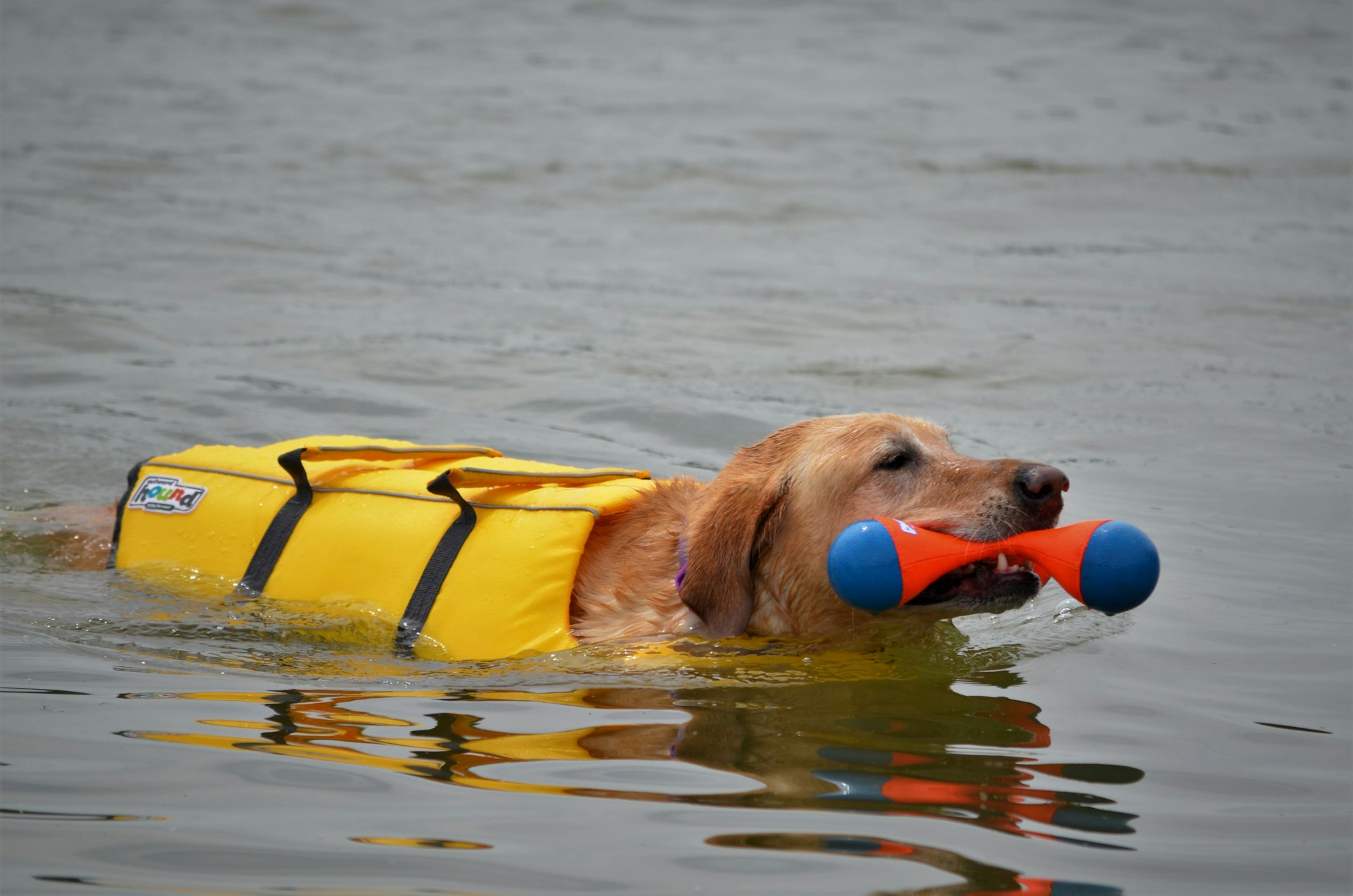
Celebrating near the water, whether it’s a lake, pool, or boat dock, can be a highlight of summer. Many dogs enjoy swimming or relaxing with the family outdoors. But water environments come with their own set of hidden dangers, especially around the Fourth of July when distractions are high and supervision can slip.
Dogs Can Drown, Even Strong Swimmers
Despite the common belief that all dogs are natural swimmers, not every breed is built for the water and even those who are can get into trouble. Panic, fatigue, or rough currents can put even a confident swimmer at risk. Older dogs or those with joint issues may struggle to stay afloat, and excited puppies can overestimate their abilities.
If your dog is near water, supervision is essential. Never assume they’re safe just because they’ve been in that lake or pool before.
Watch for Blue-Green Algae and Contaminated Water
Some lakes and ponds develop toxic algal blooms during summer, especially in warm, still water. Dogs may drink the water or lick it off their fur after swimming. Blue-green algae can be deadly even in small amounts, causing liver failure or neurological symptoms within hours.
Check posted signs at public water access points and always inspect the water’s surface. If it looks green, cloudy, or has a foul odor, keep your dog out entirely.
Life Jackets Aren’t Just for People
If you’re taking your dog out on a boat, kayak, or paddleboard, a properly fitted canine life vest is a must. Even if they love the water, accidents happen, and a vest gives you time to react. Choose one with a sturdy handle so you can lift them out of the water if needed.
Also, avoid letting dogs leap off docks or swim too far from shore. Fireworks, engine noise, or sudden splashes can startle them, making it hard to navigate back safely.
Taking water safety seriously means you can still enjoy the day while protecting your dog from real but preventable risks. A few extra steps go a long way toward keeping everyone afloat, literally and figuratively.
After the Fireworks: Recovery and Cleanup
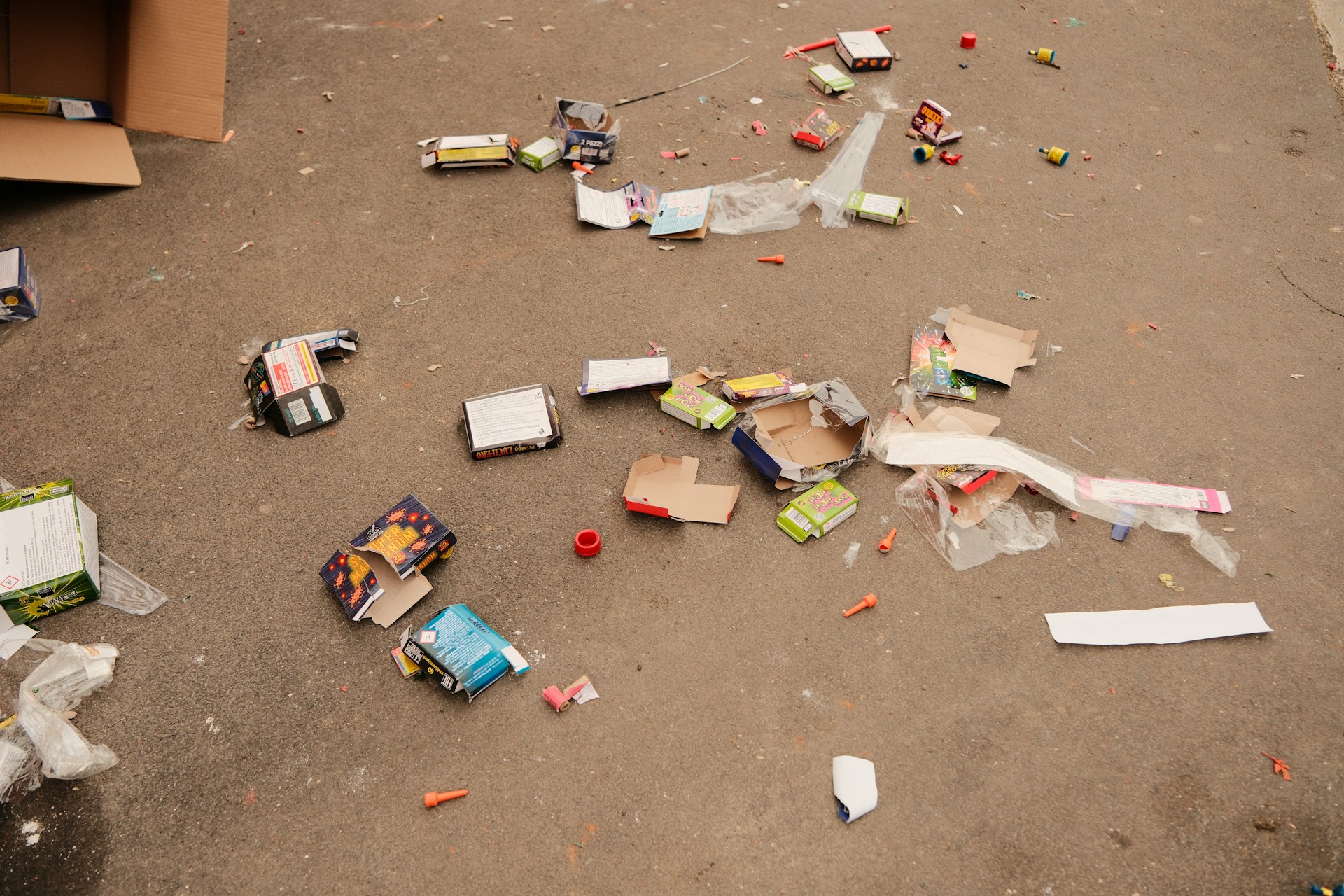
Even after the last firework has faded from the sky, your dog may still be feeling the effects. The sudden bursts of light and sound can leave dogs tense, disoriented, or restless for hours. For some, it’s not just noise; they associate the entire evening with stress.
Reassure, Don’t Reinforce the Fear
If your dog seems shaky or withdrawn, give them space to settle. Let them come to you when they’re ready. Gentle petting, a familiar routine, and a calm environment go a long way toward helping them feel safe again.
Avoid making a big fuss over their fear. Reassurance is fine but try to keep your tone and actions steady and relaxed. You’re modeling that everything is okay now, and they’ll pick up on that energy more than words.
Stick to their usual schedule as soon as you can. Regular mealtimes, walks, and bedtime help re-establish normalcy, which brings comfort on its own.
Watch for Lingering Anxiety
Some dogs may seem fine at first, then show signs of nervousness the next day - pacing, panting, hiding, or refusing food. If that happens, continue offering a quiet, secure space and keep interactions low-key. If symptoms persist or worsen, consult your vet for support. Chronic stress can lead to behavior changes if left unaddressed.
RELATED: Why Is My Dog Shaking?
Clean Up Carefully - Debris Can Be Toxic
Don’t overlook the yard, driveway, or sidewalk the next morning. Firework debris can contain chemicals and sharp fragments that pose serious health risks to curious dogs. These leftovers may look like toys or treats to a sniffing nose.
Common dangers include:
- Burned-out firecracker shells
- Singed cardboard tubes or fuses
- Unexploded fireworks or sparklers
- Aluminum or plastic fragments
Walk the area thoroughly and dispose of debris in a sealed bag, out of your dog’s reach. If you walked your dog in a public space the night before, check their usual path for hazards as well.
The celebration might be over, but safety doesn’t stop when the sky goes dark. A few extra steps can help your dog return to normal faster and protect them from post-party dangers that are easy to miss.
RELATED: Understanding Dog Body Language
What If Your Dog Goes Missing? Step-by-Step Guide
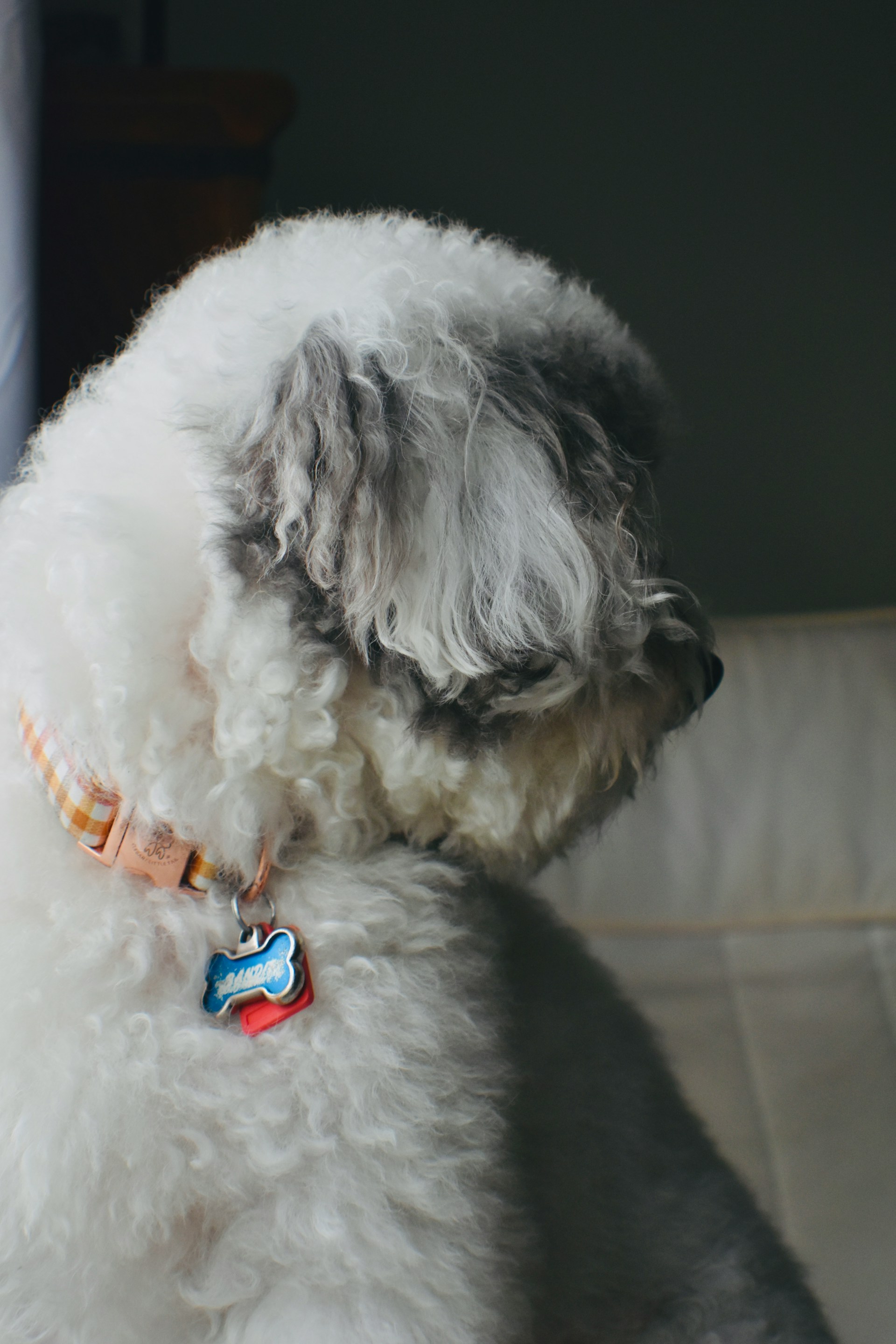
Despite the best precautions, fireworks anxiety can sometimes cause dogs to flee. If your dog escapes during the Fourth of July, it’s crucial to act quickly, but stay focused. Dogs often don’t go far right away, and swift action improves the chances of a safe return.
Step 1: Search Your Immediate Area
Start by walking your neighborhood slowly and calmly. Call your dog’s name in a soft, upbeat tone. Bring a favorite squeaky toy, leash, or treat bag - something familiar that might draw them out.
Check under porches, behind shrubs, garages, sheds, or open vehicles. Fearful dogs often hide in small, dark places and may not respond right away, even if they hear you.
Step 2: Notify Local Shelters and Animal Control
Contact nearby shelters, rescue organizations, and your local animal control department. Leave a detailed description and provide:
- Your dog’s name and breed
- Color and markings
- Collar and tag details
- Microchip number (if available)
- Any unique behaviors or features
Many shelters update their websites or social pages with found pets. Keep checking and follow up regularly.
Step 3: Use Online Lost Pet Tools
Digital tools can spread the word quickly:
- Post on local Facebook groups or Nextdoor - include location, clear photos, and contact info
- Create a listing on PawBoost - notify shelters and alert neighbors
- Check local lost-and-found boards and apps like Petfinder or Craigslist
Be sure to monitor responses and filter for legitimate tips. Avoid sharing your exact home address publicly.
Step 4: Alert Your Microchip Registry
If your dog is microchipped, contact the registry right away. Most companies allow you to mark a pet as lost, which can trigger alerts to area shelters and vet clinics. Make sure your contact info is current in their system. This step only works if your phone number and email are up to date.
Step 5: Stay Visible and Stay Hopeful
Put up flyers around your neighborhood with a photo, brief description, and your phone number. Offer a reward if you’d like but focus more on clarity and visibility than incentives.
Many dogs are recovered within 24–48 hours, especially when their guardians respond quickly and use multiple channels to spread the word.
It’s a deeply stressful experience, but you’re not alone. With clear action and community support, there’s a strong chance your dog will come home safely.
Vet-Backed Advice: When to Call for Professional Help
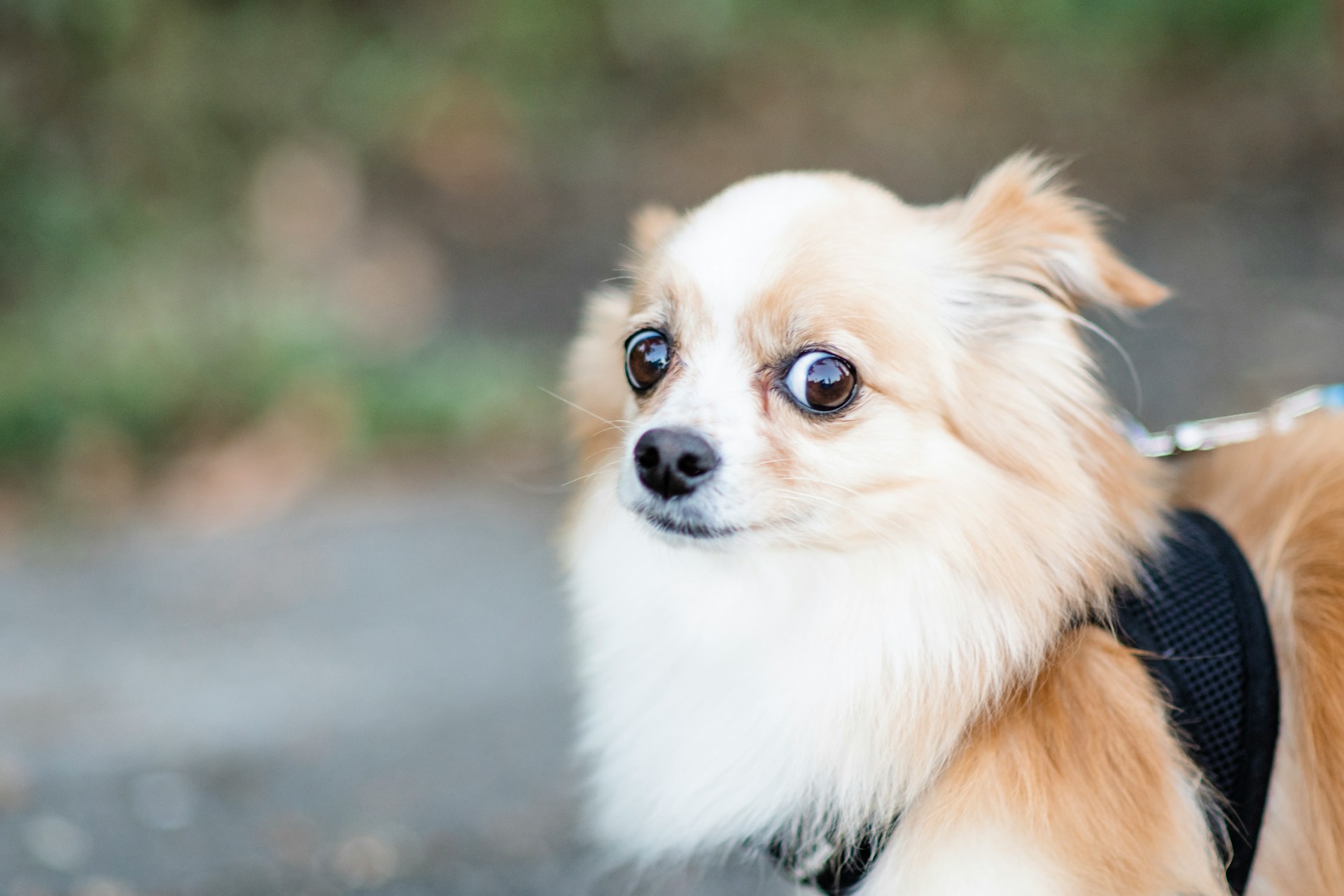
Sometimes, despite all your preparation, your dog’s fear may be too overwhelming to manage on your own. If your dog shows signs of extreme anxiety like nonstop shaking, vomiting, self-harm, or complete withdrawal, it’s time to reach out to a professional. These are not just “nervous quirks.” They’re real distress signals that deserve attention.
If your dog can’t eat, won’t come out of hiding, or starts destroying objects in a panic, that’s more than just a bad night. These reactions can become part of a longer-term anxiety pattern if not addressed early. Left unchecked, it may take weeks (or longer) for some dogs to return to normal after a traumatic experience.
Your first call should be your regular veterinarian. They can evaluate whether your dog is experiencing physical symptoms from stress (like digestive issues or dehydration), and help you decide on a plan. They may recommend calming medications or refer you to a certified veterinary behaviorist.
Many emergency animal hospitals remain open over the holidays. If your dog’s anxiety seems dangerous or if they’ve been exposed to fireworks debris, alcohol, or toxic food, it’s best to err on the side of caution and call.
Avoid the temptation to try over-the-counter calming products without guidance. While natural supplements may seem harmless, some ingredients can interact with other medications or affect dogs differently based on size, breed, or health conditions. Your vet can help you choose something effective and safe, or let you know when medication might be the better route.
As with any behavioral concern, earlier intervention makes a big difference. You’re not overreacting by asking for help. In fact, that kind of attentiveness could prevent a deeper fear from taking hold and give your dog a better shot at future holidays feeling far less scary.
Final Thoughts: Keeping Your Dog Safe Is the Best Celebration
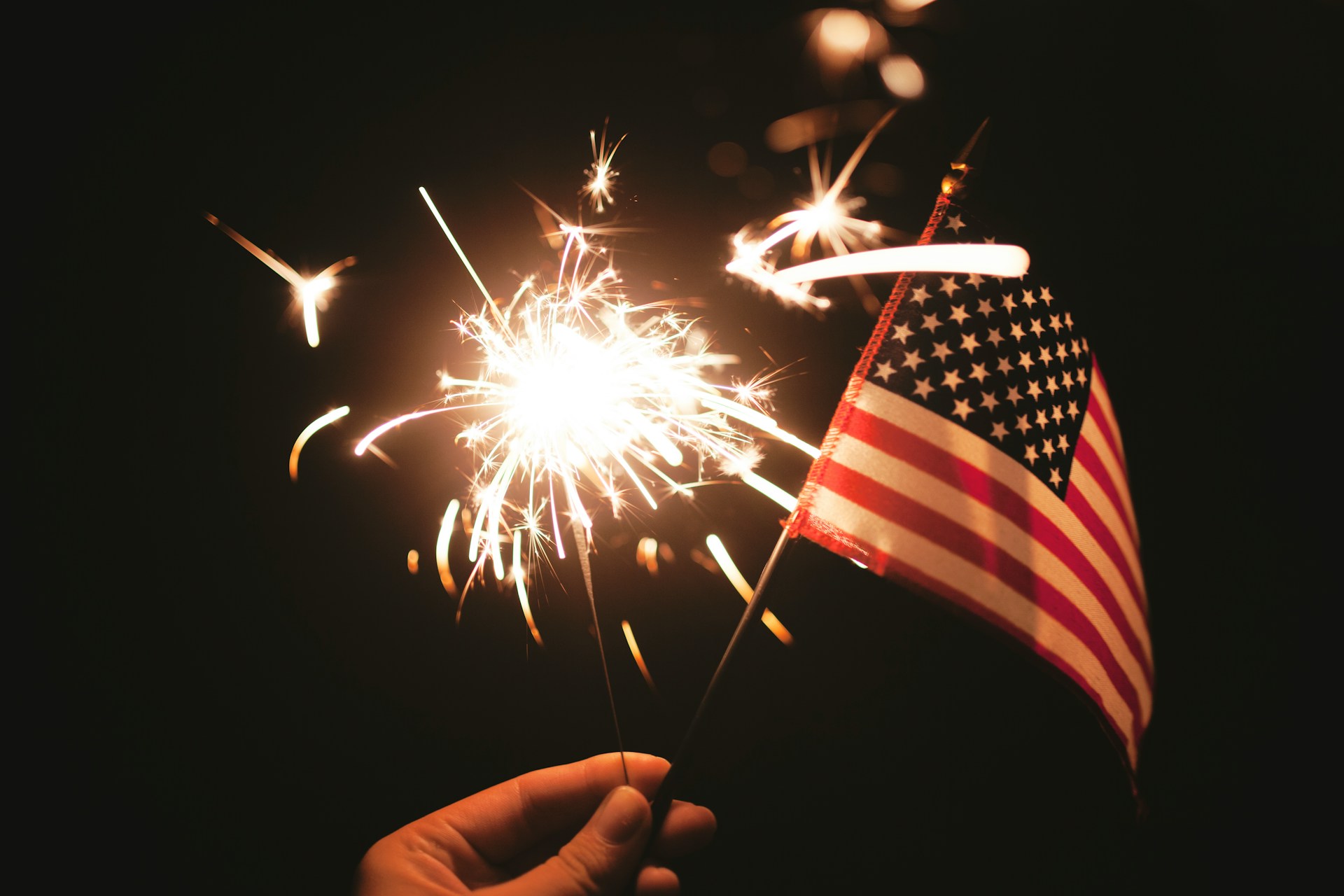
The Fourth of July brings excitement, laughter, and memories we look forward to all year. But for your dog, it can also bring confusion and fear. That’s why your preparation, your attention, and your steady presence matter so much. They don’t understand the noise or the crowds, but they understand you.
Every effort you make to plan ahead, whether it’s setting up a quiet room, double-checking an ID tag, or sitting close during fireworks, tells your dog they’re not alone. You become their comfort, their safety net, and their calm in the chaos.
Keeping your dog safe during the 4th of July doesn’t require perfection. It just takes awareness, a bit of time, and the willingness to adapt. And in return, you protect not just their physical health, but their trust and sense of security too.
With the right steps, this holiday can still be joyful for both of you. The music, the grilling, the fun - they all mean more when your four-legged family member is resting peacefully, knowing they’re cared for.
Celebrate with awareness. Celebrate with love. Because when your dog feels safe, that’s a celebration worth having.
Scroll down to see FAQs about 4th of July safety for dogs.
What To Read Next
Hypoallergenic Puppies
20 Best Dogs for Kids
Frequently Asked Questions
What is the safest place for my dog during fireworks? The best place for your dog is indoors, in a quiet, secure room where they feel most comfortable. Choose an interior space away from windows or outside walls, like a bedroom, bathroom, or closet. Add familiar bedding, toys, and calming sounds like a fan or white noise. Let your dog choose their preferred hiding spot if possible and keep the environment predictable and calm.
Are calming treats safe? Calming treats can be safe and helpful for mild anxiety, especially those made with natural ingredients like L-theanine, melatonin, or chamomile. But not all products are created equal. Avoid anything new on the day of the event and always check with your vet, especially if your dog is on other medications or has health concerns. It’s also important to follow dosing guidelines carefully.
Can I take my dog to fireworks if they’re calm? Even if your dog seems unfazed by loud sounds, it’s still risky. Fireworks can be unpredictable, and new environments (crowds, smoke, strange smells) can cause unexpected stress. Dogs hide fear well, and a sudden panic response in a public setting can be hard to manage. It’s safest to leave your dog at home in a secure space and enjoy the display knowing they’re comfortable.
What if my dog already has bad firework trauma? If your dog has a history of severe anxiety around fireworks, it’s best to speak with a veterinarian or certified behaviorist. Desensitization training can help over time, but they may also need medical support during the peak holiday. Keeping them indoors, using calming aids, and sticking to a quiet routine can reduce the immediate impact. Long-term fear can be managed, but it often takes a personalized plan.
How soon should I start prepping for next year? Ideally, begin prepping a few months in advance. That gives you time for gradual desensitization training, testing calming aids, and getting veterinary input if needed. That said, even starting a few weeks ahead can still make a noticeable difference. Preparing early helps you stay calm too, which your dog will absolutely notice.
How can I calm my dog if I’m not home? If you know you’ll be away during fireworks, plan ahead. Set up a quiet space with blackout curtains and calming sounds. Use a pheromone diffuser or approved calming product if recommended by your vet. Ask a trusted friend, pet sitter, or neighbor to stay with your dog during the most active hours. Never leave them outside unattended. If separation adds to their anxiety, talk to your vet about ways to manage both concerns safely.



